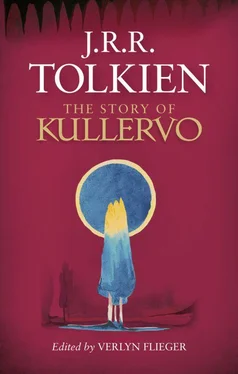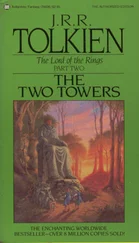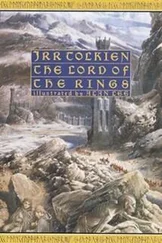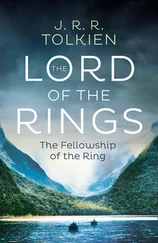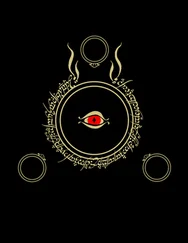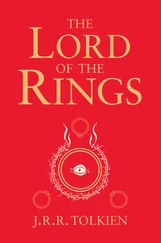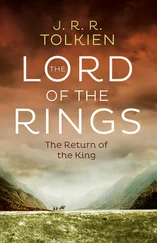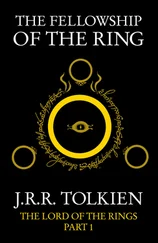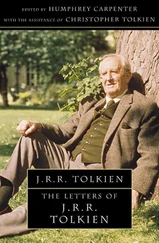In terms of narrative form, Tolkien’s ‘Kullervo’ falls somewhere between the short stories and the long poems in that it is cast in a mixture of prose and verse, interpolating long passages of poetry into a stylized prose narrative. Like his Sigurd and Gudrún it is a love story of doom with no reprieve for its human players, and like his Fall of Arthur it is a story of the intermixture of fate and human decision as the relentless determinants of human life. Also, like The Fall of Arthur but unlike Sigurd and Gudrún , it is unfinished, breaking off before the climactic final scenes, which remain only sketched in jotted outline and notes. Its unfinished state is also sadly typical of much of Tolkien’s work; more of his ‘Silmarillion’ stories remained works in progress at the time of his death than were ever brought to completion in his lifetime. Aside from this negative qualification, The Story of Kullervo would deserve a place in the continuum of Tolkien’s art for all of the above-cited reasons.
But the greatest importance of The Story of Kullervo , as noted above, is as the preliminary to one of the foundation narratives of his legendarium, The Children of Húrin , its central character being the clear precursor of that story’s protagonist, Túrin Turambar. Tolkien also cited other models for Túrin, such as the Icelandic Edda from which he borrowed Túrin’s dragon-slaying episode, and Sophocles’s Oedipus, who is (as defined above), like Túrin, a tragic hero in search of his own identity. Nevertheless, it is no exaggeration to say that without Kalevala there would be no Story of Kullervo , and without The Story of Kullervo there would be no Túrin. Certainly without the story of Túrin Tolkien’s invented mythology would lack much of its tragic power, as well as its most compelling narrative trajectory outside The Lord of the Rings . We can also recognize in ‘Kullervo’, though more distantly, a number of repeating motifs that run through Tolkien’s fiction: the fatherless child, the supernatural helper, the charged relationship of uncle and nephew, and the cherished heirloom or talisman. Although these motifs are translated into new narrative circumstances and sometimes turned in quite different directions, they nevertheless form a continuum that stretches from The Story of Kullervo , his earliest serious fiction, to Smith of Wootton Major , the last of his stories published in his lifetime.
In the above-mentioned letter to Waldman Tolkien expressed his hope that his invented myth would leave scope for ‘other minds and hands wielding paint and music and drama’ ( Letters , pp. 144–5). He might have been thinking of Kalevala here also, for his reference to paint and music and the scope for other hands may well be an allusion to the translations of Kalevala material into paint and music by other artists who found in it inspiration for their art. Two prominent examples are the classical composer Jan Sibelius and the painter Akseli Gallen-Kallela, two of the best-known Finnish artists of the late 19th and early 20th century. Sibelius mined Kalevala for his orchestral ‘Lemminkainen’ and ‘Tapiola’ suites and his longer ‘Kullervo Suite’ for orchestra and chorus, turning myths into music. Akseli Gallen-Kallela, Finland’s foremost painter of the modern era, produced a series of scenes from Kalevala including four paintings illustrating key moments in the life of Kullervo. The popularity of this character, and his attraction for artists, suggests that he can be seen as a kind of folkloric embodiment of the violence and troubled irrationality of the equally troubled modern age. It does not take a great stretch of imagination to see Tolkien’s Túrin Turambar, a product of the same war-torn age, in the same light as the same sort of hero.
The narrative trajectory of Tolkien’s story follows closely runos 31–36 in Kalevala . These were titled in Kirby’s translation, ‘Untamo and Kullervo’, ‘Kullervo and the Wife of Ilmarinen’, ‘The Death of Ilmarinen’s Wife’, ‘Kullervo and his Parents’, ‘Kullervo and his Sister’, and ‘The Death of Kullervo’. Although presented as separate poems, they comprise a coherent (if not always fully integrated) sequence telling the continuous story of a catastrophic quarrel between brothers, which leaves one brother dead and the other the murderous guardian of the dead brother’s newborn son, Kullervo. Mistreated and abused by both his guardian and the guardian’s wife, the boy survives an unhappy childhood including three attempts at his murder — by drowning, burning, and hanging — and ultimately exacts vengeance on both of them, but is himself subsequently destroyed by his discovery of his unwitting incest with a sister he did not recognize until too late. Tolkien’s treatment deepens the story, prolonging suspense and adding both psychology and mystery, developing the characters while preserving and enhancing the pagan and primitive qualities that first attracted him to Kalevala .
The Story of Kullervo exists in a single manuscript, Bodleian Library MS Tolkien B 64/6. This is a legible but rough draft, with many crossings-out, marginal and above-the-line additions, corrections, and emendations. The text is written in pencil on both sides of thirteen numbered bi-fold foolscap folios. The main narrative breaks off abruptly halfway down the recto of folio 13, at a point about three-quarters of the way through the story. It is followed on the same page by notes and outlines for the remainder (Plates 4, 5), which fill the rest of the space and continue on to the top portion of the verso. There are in addition several loose sheets of variable size containing what are clearly preliminary plot outlines, jotted notes, lists of names (Plate 3), lists of rhyming words, and several drafts of one long verse passage of the story, ‘Now in sooth a man I deem me’. If, as appears likely, MS Tolkien B 64/6 contains the earliest and (aside from the note pages) the only draft of the story, Tolkien’s revisions on this manuscript must stand as his final ones.
I have left intact Tolkien’s sometimes quirky usage and often convoluted syntax, in a few instances adding punctuation where necessary to clarify meaning. Square brackets enclose conjectural readings and words or word-elements missing from the manuscript but supplied for clarity. His use of diacritical marks over the vowel — chiefly macron but also occasionally breve and umlaut — is also inconsistent, attributable more to speed of composition than intentional omission. False starts, cancelled words and lines have been omitted, with four exceptions. In these instances, wavy brackets enclose phrases or sentences cancelled in the MS but here retained as of particular interest to the story. Three such cancelled passages give evidence of Tolkien’s long preoccupation with the nature of magic and the supernatural. The first two occur in the opening sentence. These are: 1) ‘of magic long ago’; 2) ‘when magic was yet new’. A third, the long sentence beginning ‘and to Kullervo he [Musti] gave three hairs…’ refers to Kullervo’s supernatural helper, the dog Musti, and is also evidence of the story’s engagement with magic. The fourth, which occurs later in the text is the possibly autobiographically-related, ‘I was small and lost my mother…’
I have preferred not to interrupt the text (and distract the reader) with note numbers, but a Notes and Commentary section follows the narrative proper, explaining terms and usage, citing references, and clarifying the relationship of Tolkien’s story to its Kalevala source. This section also includes Tolkien’s preliminary outline notes for the story, enabling the reader to track apparent changes and follow the path of Tolkien’s imagination.
Читать дальше
